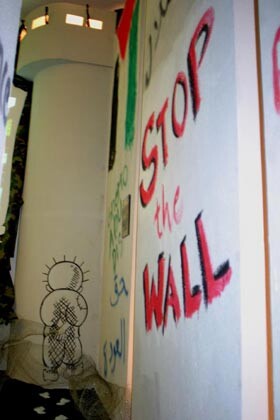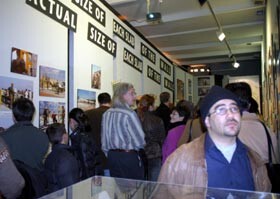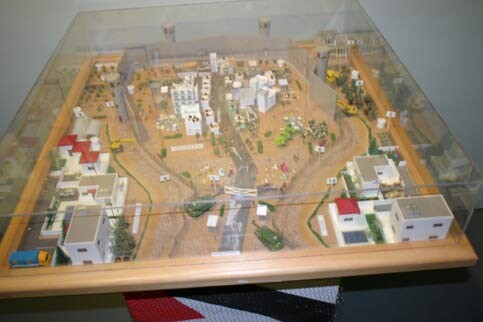The Daily Star 16 February 2004

Part of the Stop the Wall exhibition installation, which simulates the wall now winding its way through the West Bank (Photo: Mary Nazzal)
Combining photography, sound effects, replicas of the Israeli-built double walls, medieval-style observation towers, and barbed wire ripping through seized land, the Stop the Wall exhibition, which opened in Amman on Saturday, triggers feelings of pain, anger and claustrophobia.
And it is precisely these emotions that Mary Nazzal, 24, the lone organizer of the event, seeks to invoke among the visitors, in her quest to raise public awareness, to help mobilize the first effective grass-root campaign against the barrier in Jordan, before moving on to other Arab countries.
“Nothing I can paint, draw or build can really show the magnitude of what is happening on the ground, and the gravity of this wall,” said Nazzal, Jordan representative for the Anti-Apartheid Wall Campaign, a Palestinian-based international network of web-connected activists.
“But by recreating the experience … I deliberately want people to get uncomfortable and angry, in order to mobilize and move,” she told The Daily Star on the sidelines of the exhibition, held at the Darat al-Funun - the Khalid Shoman Foundation - in Amman.
It runs through Feb. 19. The Jordanian of Palestinian origin, who has been campaigning against the wall since construction began in 2002, had been toiling for weeks to create the overpowering atmosphere of a large prison, or a detention camp, the key result of the planned 700-kilometer separation wall, snaking through occupied Palestinian lands.
Nazzal’s husband, Aysar Batayneh, her Anglo-Indian mother, and scores of other sympathizers, worked equally hard to transform the beautiful interiors of the historic building housing the gallery, into a suffocating box. And they all took turns in writing multi-lingual graffiti on the walls.
“Where are the Arabs?” asked one. “Stop the wall,” “justice will not be silenced,” “right is might,” and “we want to live,” read others.
The Amman exhibition clearly shows the horror brought about in the course of controlling people and land.
Like many activists in the region, Nazzal faces an uphill battle in being able to mobilizing the masses across the largely autocratic Arab world, where civil society remains marginalized, weak and ineffective. But she is bent on succeeding in her campaign to stop what she feels is the most “black or white” issue in recent history.
“We want to introduce people to the idea of what it means to be trapped, to feel suffocated. These people wake up every morning, facing this wall while their movement is restricted,” said Nazzal, who earned her postgraduate degree in political science from Columbia University in New York in 2001.

Opening night at the Stop the Wall exhibition in Amman, Jordan (Photo: Mary Nazzal)
Huge concrete slabs dominate the exhibition hall. They are intended to give visitors a glimpse of the wall’s breadth, even though the slabs stand at half the size of the eight-meter high walls in the occupied West Bank, a three-hour drive by car from Amman. Visitors can peak through small openings between the gray slabs to view images of Palestinian life continuing behind the wall.
On display are 100 photographs, all from the collection of the Anti-Apartheid Wall Campaign, documenting the wall and its destruction of life and property. Among the striking images are those of a young school boy, his black eyes desperately gazing through the iron bars of a closed yellow gate, of old Palestinian women squeezing themselves through the temporary wall in occupied Jerusalem, and of aging men clinging to their farmland while Israeli bulldozers uproot 700-year-old trees from their olive groves.
In the background, visitors hear heart-wrenching personal testimonies of Palestinians, interrupted by the unnerving noise of bulldozers flattening homes, Israeli soldiers ordering residents to vacate their homes, demonstrators shouting pro-Palestinian slogans, sirens of ambulances wailing, and deafening cries of children.
“I do not care any longer,” said the sad voice of a man in a recorded message. “Either I live, or I die.”
A large map of the West Bank, detailed with the present and future route of the wall, is also featured in the exhibit.
“It is imperative that people digest the map. It is frighteningly clear that if completed, Israel will entirely enclose every single Palestinian village with walls, electronic fences, check points, and so on,” Nazzal said. “Incongruous Palestinian towns, huge Israeli colonial settlements, and Jewish-only roads that are featured in the map, illustrate the wall’s strategic goal.”

A model of Qalqilya, one of the Palestinian towns hardest hit by Israel’s wall (Photo: Mary Nazzal
A hand-made model of the West Bank village of Qalqiliya, rich in farming land and water and fully encircled by the wall, exposes the horrific effects of a completed barrier under phase one of the wall project. The thick barrier runs deep into occupied territory, to provide protection to residents of the nearby Alfei Manashe, one of the largest Israeli settlements. As a result, a total of 36 Palestinian water wells are now under full Israeli control.
“This model is representative of the rest of the Palestinian villages and towns that are going to become enclaves, and completely ghettoized with fences and walls … this is the Zionist goal,” said Nazzal, pointing to figurines of Palestinian women made from tiny shreds of her childhood collection of colorful ribbons. “There, they have also annexed a lot of Palestinian land, and the people are truly suffocating and it is a form of quiet transfer because already 20 percent of population has left.”
By now, the story of the separation wall has become clear.
The feeling of isolation is overwhelming, as the barrier will affect a total of 206 villages and town, inhabited by 875,000 Palestinians, or 38 percent of the West Bank population. Families will be separated from each other, peasants from their lands, and children from schools while Israel soldiers control the entry and exit of any individual.
Economically, the barrier to trade will also seal the fate of the Palestinian communities in the West Bank, further aggravating record high unemployment rates soaring since the intifada began in 2000.
Israel, which began constructing the wall almost two years ago, says it is vital to protect the Jewish state from attacks by Palestinian resistance fighters.

A model of a Palestinian woman waiting behind a fence sitting on Israeli garbage (Photo: Mary Nazzal)
The exhibition in Amman could not have been more timely, given the battle at the Hague-based International Court of Justice (ICJ), which is set to rule on the legal consequences of the barrier later this month.
Ironically, Jordan, which signed a controversial peace treaty with Israel in 1994 and angered many in the region because of its overtures to Israel over the past five decades, is leading Arab opposition against the wall. It has pressed for the immediate destruction of the barrier in a legal dossier it presented to the ICJ in late January.
Jordan, which ruled the West Bank from 1950 until it lost it to Israel during the 1967 war, deems the wall a threat to its national security. It says the separation barrier ends any prospects for Middle East peace based on a two-state solution, and could ultimately encourage a transfer of Palestinians to Jordan, harming the delicate demographic balance and further depleting scarce natural resources. Half of Jordan’s 5.2 million population is of Palestinian origin, mostly refugees from Israel’s creation on parts of British Mandate Palestine in 1948 and the 1967 war.
“This wall issue for me is as significant as 1967 and 1948,” said Nazzal. “It has shaken up everyone. It is just so huge … it is the most significant change on the ground since 1967.”
The wall offers a valuable chance for Palestinians to promote their cause to the world, putting a human face to their daily suffering at the hands of their occupiers, instead of talking in abstract terms about seizures and curfews, concepts that remain alien to average Westerners, according to Arab and foreign political activists.
These activists could also capitalize on the dialogue that the wall has stirred among Israelis as to whether it is really needed.
“The wall also evokes images both of the Berlin Wall that was heroically torn down, and images of apartheid for people who really understand what it really was,” said Nazzal.
This article was originally published in The Daily Star
Related Links


